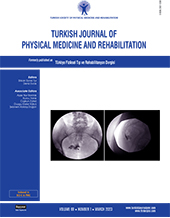Can isokinetic test be a supportive tool for unilateral knee arthroplasty decision?
2 Department of Orthopaedic Surgery, University of Missouri Kansas City, Kansas City, USA
3 Department of Physical Medicine and Rehabilitation, Memorial Şişli Hospital, Istanbul, Türkiye
4 Department of Physical Medicine and Rehabilitation, Medical Faculty of Istanbul Medipol University, Istanbul, Türkiye
5 Department of Orthopaedic Surgery, Şişli Memorial Hospital, Istanbul, Türkiye
6 Department of Physiotherapy and Rehabilitation, Üsküdar University Faculty of Health Sciences, Istanbul, Türkiye DOI : 10.5606/tftrd.2023.12374 Objectives: This study analyzed whether the isokinetic muscle strength of bilateral knee osteoarthritis patients undergoing unilateral total knee arthroplasty (TKA) is a predictor for prior surgery side.
Patients and methods: In the prospective study conducted between April 2021 and December 2021, 58 knees of 29 unilateral TKA candidates (6 males, 23 females; mean age: 66.7±7.4 years; range, 53 to 81 years) were enrolled. The patients were divided into surgical (n=29)and nonsurgical (n=29) groups. The knees of patients with bilateral knee osteoarthritis (Stage III or IV) according to the Kellgren-Lawrence (KL) scale were scheduled for unilateral TKA. An isokinetic testing system was used to assess knee flexor and extensor muscle strength (peak torque) at angular velocities of 60°/sec and 180°/sec (five cycles per velocity). The radiological (X-ray-based KL scale and magnetic resonance imaging-based quadriceps angle) and clinical findings (isokinetic test and Visual Analog Scale pain scores) in both groups were compared.
Results: The mean symptom duration was 10±5.4 years. The KL score and quadriceps angle showed no significant differences (p=0.056 and p=0.663, respectively). Isokinetic test results were in accordance with the clinical results of the surgery group. In the isokinetic evaluation, both the 60°/sec concentric extension (35.00 vs. 46.00, p=0.002) and flexion peak torque (18.00 vs. 26.00, p=0.001) values were significantly lower in the surgical group than in the nonsurgical group.
Conclusion: Isokinetic testing can be a supportive tool for assessing the prior side of TKA in patients with bilateral knee osteoarthritis. Further studies are required to support these findings.
Keywords : Arthroplasty, knee, muscle strength dynamometer

















